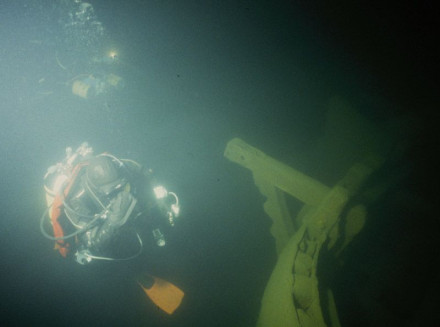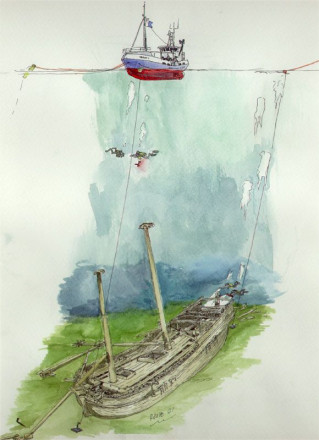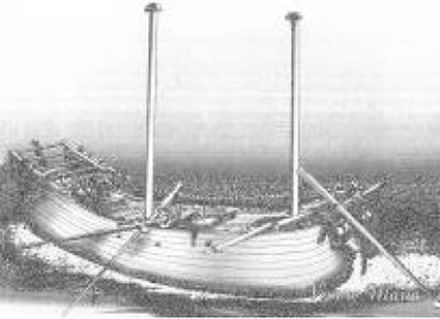History
Vrouwe Maria was a two-masted merchant ship that wrecked en route from Amsterdam to St. Petersburg in the autumn of 1771.
It was on a stormy night in the outer archipelago of Nauvo, that left her heavily damaged; a few days later she sank. According to the entries of the Sound Customs House in Denmark, she carried a cargo of sugar, dyestuff, zinc, cloths, and single items for which the customs fees seem unusually high. Vrouw Maria is known as a treasure ship because of her cargo consisting of art treasures bought by Russian aristocrats and Catherine the Great, including Dutch paintings from the 17th century. A part of the cargo was salvaged soon after the shipwreck, but the majority of it went down with the ship.
Research history
The wreck was discovered using a side scan sonar in 1999. The Finnish Maritime Museum started field research on the wreck in the summer of 2000. Researchers, who were aided by a group of voluntary divers, documented the wreck by photograph and video. The work in different archives goes on. As a result of the studies in different archives, we know about the quality of Vrouw Maria's cargo, the events of the shipwreck, the attempts to salvage the ship, and about the subsequent phases of some of the things that were salvaged.
In addition to this, certain auction lists and Clara Bille's doctoral theses 'De tempel der kunst of het kabinet van den heer Braamcamp' (Amsterdam 1961) tell us roughly what the works of art in Vrouw Maria's cargo were.

Discovery
The very first documents about the history of Vrouw Maria were found by Dr. Christian Ahlström in the Finnish National Archives as early as in the 1970's. Ahlström gathered up pieces of information from different archives and he published them for the first time in 1979 (Sjunkna Skepp, Lund). The most important source for researchers is the ship's protest, which was found in the municipal archives of Turku. The document consists of an extract of Vrouw Maria's logbook and a list of the things that were salvaged. In the Diplomatica Collection in Riksarkivet, the Swedish National Archives in Stockholm, there is diplomatic correspondence concerning the attempts to search and salvage the ship.
Mr. Rauno Koivusaari and other members of a society called Pro Vrouw Maria managed to locate the wreck using a side-scan sonar in the summer of 1999.

Description
Two-masted merchant vessel originaly a snow (snauw) ship with a typically snow mast. After being refitted in 1748 she was rigged as a koff.
Length: 81 1/4 foot,
Width: Within hull 20 foot 5.5 inches,
(Amsterdam foot of 0.283 meters, inches
2,573 cm each.)

The most interesting find by Finish researcher Christian Ahlstrom on the provenance of the ship was a sales contract dated August 18, 1766 (sales of ships through brokers, file nr. 5071, Gemeente archief Amsterdam). This document mentions the koff ship Vrouw Maria.
It was discovered that the main-mast of the wreck bore traces of the fittings of the snowmast which had been removed when the ship was rebuilt as a koff ship.

Here you find a 3 D model made of the wreck
| Length | 80 Amsterdam feet (22.7 m) |
|---|---|
| Width | 20 Amsterdam feet (5.7 m) |
Status
At the depth of over 40 meters, the wreck appears well preserved.
The wreck is approximately 26 meters long and 7 meters wide. It lies on its keel on the bottom of the sea and leans on its starboard side. The masts, which are standing up, rise to a depth of 22 - 24 meters. The masts are made of three parts, and the upper parts have fallen on the starboard side of the wreck on the bottom of the sea.
Vrouw Maria is located in Finnish territorial waters. It is protected with a special protection area established around the site; diving and anchoring is prohibited without a permit from Finnish Heritage Agency.
Vrouw Maria was part of the MoSS project (Monitoring Safeguarding North-European shipwrecks sites) from 2001-2004.
Interactive installation of the Vrouw Maria.
References
- Omroep MAX.
De Gezonken Meesters documentaire. - Riikka Alvik (ed.).
The Vrouw Maria underwater project 2009-2012. - museovirasto.fi.
Vrouw Maria. - 20 years from finding the Vrouw Maria wreck.
- Christian Ahlström.
The Vrouw Maria of 1771 – An example of documentary research. - Model creator: Samuli Haataja.
3D model Vrouwe Maria.